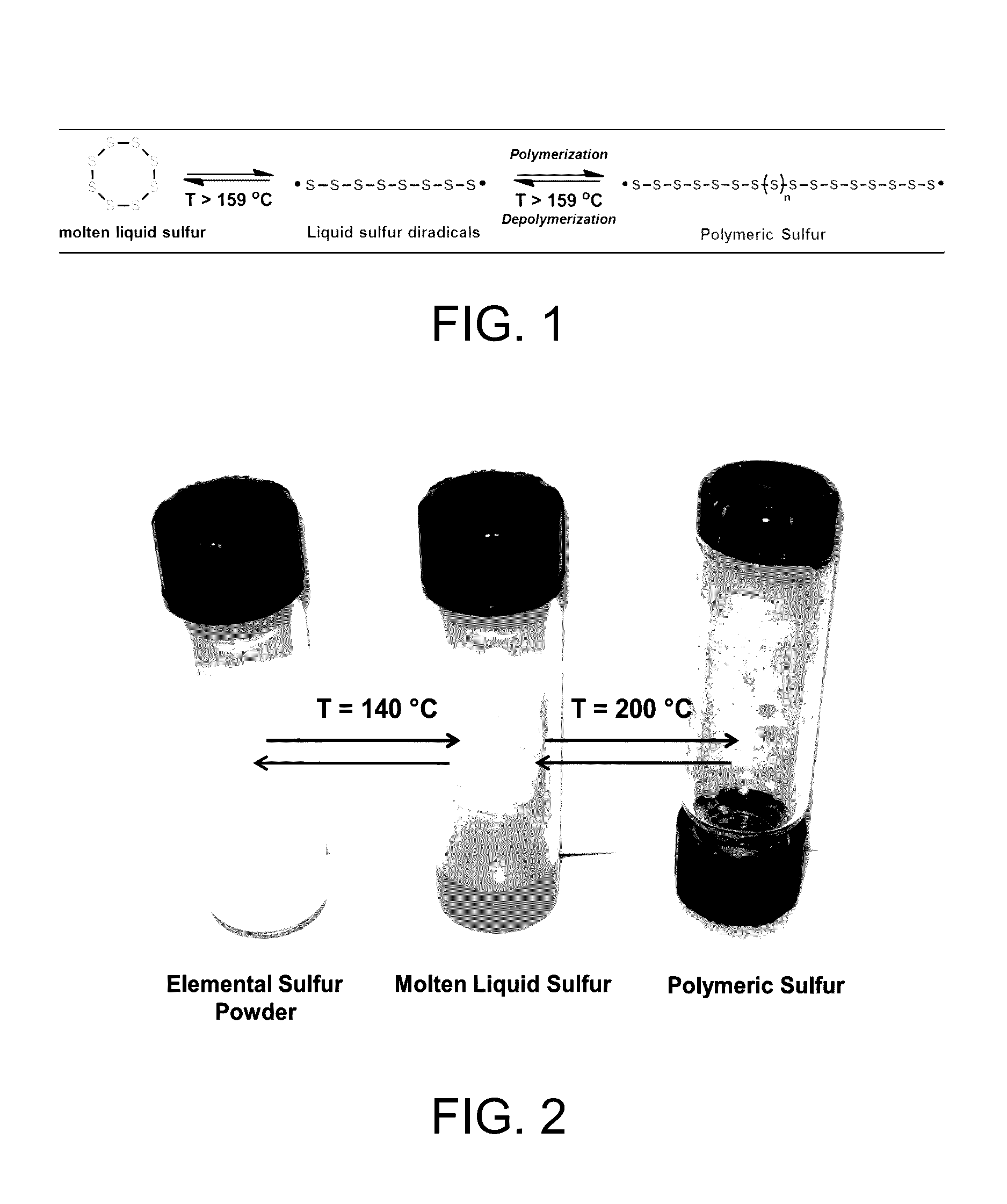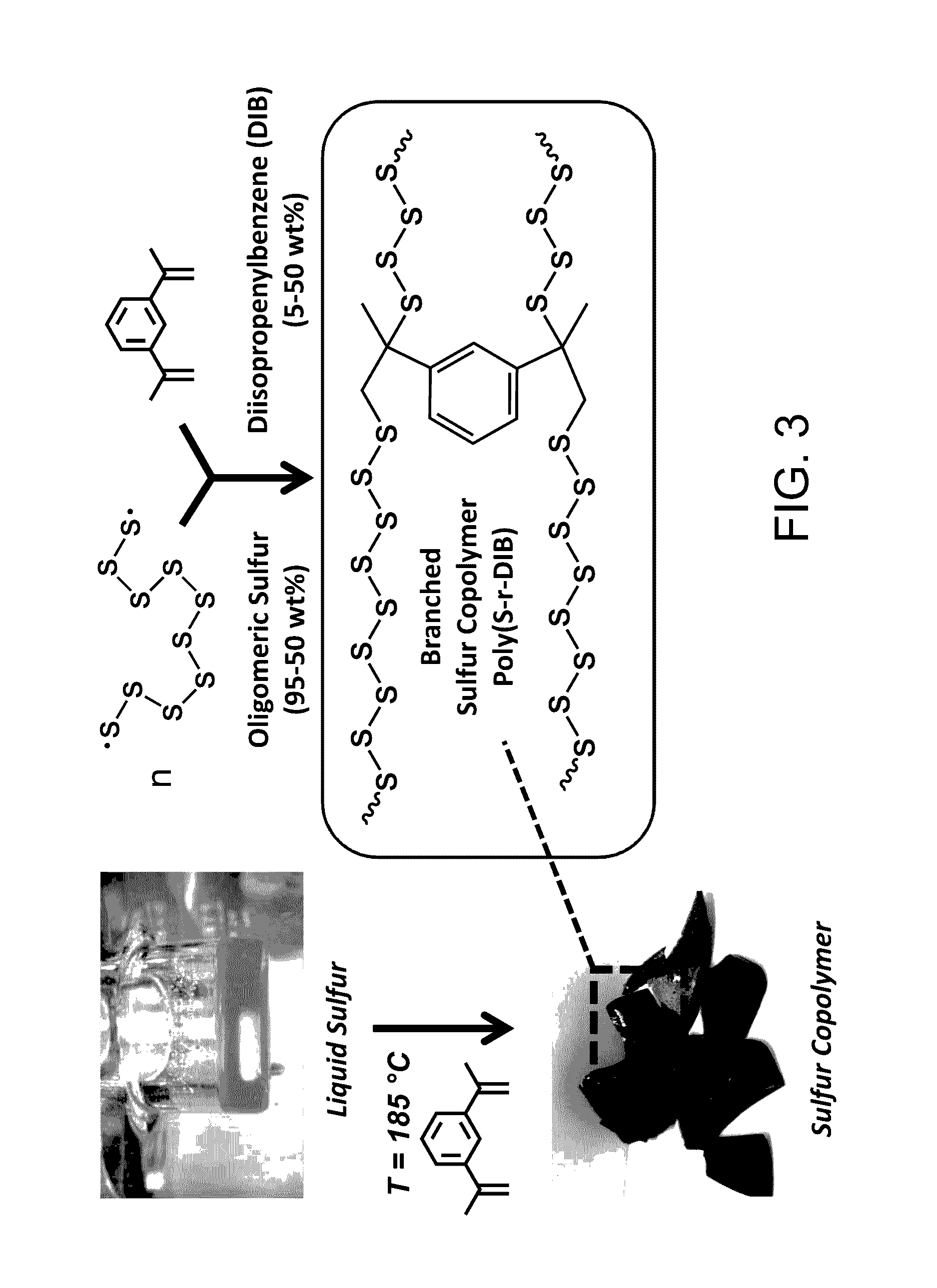Sulfur composites and polymeric materials from elemental sulfur
- Summary
- Abstract
- Description
- Claims
- Application Information
AI Technical Summary
Benefits of technology
Problems solved by technology
Method used
Image
Examples
example 1
General Procedure for the Inverse Vulcanization of Sulfur with Alkynes
[0095]A 5 mL vial equipped with a magnetic stir bar was loaded with sulfur (800 mg, 3.125 mmol) and 1-phenylpropyne (0.20 mL, 1.72 mmol). The mixture was stirred at 175° C. for 7 min yielding a very viscous red transparent fluid. The reaction was quenched by cooling to −78° C. The resulting poly(sulfur-co-phenylpropyne) was then recovered from the vial yielding a reddish brown solid (949 mg, 96%).
Monoalkyne Examples
[0096]
Dialkyne Examples
[0097]
Multi-Alkyne Examples
[0098]
example 2
General procedure for the high temperature preparation of poly(sulfur-random-(m-phenylenediamine) (poly(S-r-m-PDA)) copolymers
[0099]To a 24 mL glass vial equipped with a magnetic stir bar were added sulfur (S8, masses detailed below) and m-phenylenediamine (m-PDA, masses detailed below). The reaction was heated to about T=185° C. in a thermostat oil bath and the resulting mixture was stirred at about T=185° C. for 8-10 minutes, until bubbling ceased and vitrification of the reaction media occurred.
Preparation of poly(S-r-m-PDA) with 50-wt % m-PDA
[0100]The copolymerization was carried out by following the general method written above with S8 (2.5 g, 9.75 mmol) and m-PDA (2.5 g, 23.13 mmol) to afford a blood red solid.
Preparation of poly(S-r-m-PDA) with 33.3-wt % m-PDA
[0101]The copolymerization was carried out by following the general method written above with S8 (2.5 g, 9.75 mmol) and m-PDA (1.25 g, 11.56 mmol) to afford a blood red solid.
Preparation of poly(S-r-m-PDA) with 28.57-wt ...
example 3
General procedure for the high temperature preparation of poly(sulfur-random-(4,4′-thiobisbenzenethiol) (poly(S-r-TBBT)) copolymers
[0107]To a 24 mL glass vial equipped with a magnetic stir bar were added sulfur (S8, masses detailed below) and 4,4′-thiobisbenzenethiol (TBBT, masses detailed below). The reaction was heated to T=185° C. in a thermostat oil bath and the resulting mixture was stirred at T=185° C. for 8-10 minutes, until bubbling ceased.
Preparation of poly(S-r-TBBT) with 50-wt % TBBT
[0108]The copolymerization was carried out by following the general method written above with S8 (0.50 g, 1.95 mmol) and TBBT (0.5 g, 2.00 mmol) to afford a yellow solid.
Preparation of poly(S-r-p-PDA) with 33.3-wt % TBBT
[0109]The copolymerization was carried out by following the general method written above with S8 (0.66 g, 2.57 mmol) and TBBT (0.33 g, 1.32 mmol) to afford a yellow solid.
Preparation of poly(S-r-p-PDA) with 28.57-wt % TBBT
[0110]The copolymerization was carried out by following ...
PUM
| Property | Measurement | Unit |
|---|---|---|
| Temperature | aaaaa | aaaaa |
| Temperature | aaaaa | aaaaa |
| Length | aaaaa | aaaaa |
Abstract
Description
Claims
Application Information
 Login to View More
Login to View More - R&D
- Intellectual Property
- Life Sciences
- Materials
- Tech Scout
- Unparalleled Data Quality
- Higher Quality Content
- 60% Fewer Hallucinations
Browse by: Latest US Patents, China's latest patents, Technical Efficacy Thesaurus, Application Domain, Technology Topic, Popular Technical Reports.
© 2025 PatSnap. All rights reserved.Legal|Privacy policy|Modern Slavery Act Transparency Statement|Sitemap|About US| Contact US: help@patsnap.com



